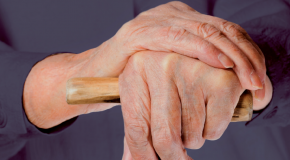The covid-19 pandemic, which assumed global proportions in the first half of 2020, has drastically impacted how healthcare systems operate. While much attention has necessarily focussed on the medical response to the pandemic, the broader impact on other aspects of health services such as the provision of care for non-communicable diseases (NCDs), like cancer, heart disease, diabetes, is more difficult to quantify. One NCD which has had a particularly low public profile during this period is osteoporosis.
Pathophysiologically—that is the process diseases take—osteoporosis and covid-19 have little in common. Nevertheless, two broad commonalities between them mean that the pandemic has complicated efforts to address the challenge of osteoporosis. The first is the demography of those most affected. For osteoporosis prevalence, comparable national data tend to be limited. Nevertheless, South Korean figures show how the number affected rises rapidly with age—a correlation seen worldwide: among women 50-59 years old in that country, 15% have the condition; for those 60-69 years, 37%; among females in their 70s, 63%; and for the over 80s, 86%.1
Similarly, severe complications arising from covid-19 are much more common among older individuals. According to early figures from the Chinese Centre for Disease Control, in that country the death rate for those diagnosed with the disease in their 50s is 1%; in their 60s, 4%; in their 70s, 8%; and for those over 80, 15%.2 This statistical link is also consistent with data found in other nations. In other words, although osteoporosis and covid-19 are clinically largely irrelevant to each other, they pose the greatest threat to the same group of people.
The second issue which the two conditions have in common is that the same health systems treat both. In most cases, this would be a trivial issue: healthcare providers within a country care simultaneously for a huge range of conditions. When a focus on any one disease comes to dominate healthcare activity to the degree that covid-19 has done, however, it can impede the ability of health systems to deal with other priorities. This may even be the case in countries which have substantial resources to devote to health, but it is not inevitably so.
We talked to experts in two countries with advanced health systems and economies—Japan and Singapore—in order to look at the impact of covid-19 on osteoporosis care there. Before proceeding, a caveat is in order. The pandemic has imposed different burdens at different periods in countries around the world during 2020. At the time of writing, in Japan the pandemic appears to have entered a third peak after those of April and July. Among Singapore’s 5.6m people, the number of new cases per day since the start of October has stayed below twenty and only three people have died since mid-June. Although covid-19 has shown an ability to come back, it is in abeyance in one of these countries.
With variations in the domestic prevalence of the disease, legal restrictions on activity have also changed. Japan’s State of Emergency lasted only from April to May and, so far, later waves have not brought similar measures. Meanwhile, Singapore has moved from its so-called Circuit Breaker measures through phases I and II of its reopening plan, each with fewer restrictions than the previous one. Currently it is looking to move into phase III. As a result, much of this discussion of the impact of covid-19 on osteoporosis care in Singapore is retrospective rather than current.
Disrupted physician-patient interaction
Neither health system has overwhelmed by covid-19, even at the height of their respective national outbreaks – although certain prefectures in Japan have recently started to face a worrying strain.3 Nevertheless, a number of practical challenges did arise in osteoporosis management. The first was overcoming pandemic-related difficulties in interaction with patients. For example, Singapore’s health system has some of the region’s longest established and best fracture liaison service (FLS) provision.4 At the peak of the outbreak, though, Manju Chandran—director of the Osteoporosis and Bone Metabolism Unit at Singapore General Hospital—explains that the FLS programme had to suspend temporarily face-to-face recruitment and patient follow-up visits. These have now been resumed.
Even for those services which continued to operate fully throughout the year, other issues impeded the traditional, in-person, meetings between patient and clinician at the heart of good osteoporosis care. Toshio Matsumoto—professor at the University of Tokushima’s Fujii Memorial Institute of Medical Sciences—explains that his hospital happens to have a separate section for osteoporosis treatment with its own unique entrance. Thus, risks to patients of infection from other diseases should be as low as possible. Nevertheless, he says that some patients have not attended his clinic “because they did not want to visit hospital during this period.” Similarly, Dr Chandran observes that many patients were themselves “reluctant to come to hospitals and clinics” during the early stages of the outbreak, a problem which dissipated as the incidence of covid-19 diminished.
Many healthcare providers around the world have turned to telemedicine as a way to overcome such problems, which extend far beyond osteoporosis care. The experts interviewed say that this expedient has potential for helping patients with osteoporosis, but both also cite potential issues. Dr Chandran notes that her clinic was able to shift a quarter of patients to teleconsultations during the outbreak. This was better than no contact but not ideal for osteoporosis care. “The inability to exam patients physically has been a negative, especially for those with back and other pain where a physical examination and X-ray are necessary,” she adds. Dr Matsumoto, meanwhile, explains that in Japan only a limited number of hospitals have telehealth systems in place, so its greater deployment then or in future would require potentially expensive infrastructure investment.
Diagnosis and initiating treatment
Another complication arising from the difficulty of in-person consultation is the challenge it presents for diagnosing people with osteoporosis and starting them on medication. The nature of the problem varies by country. So far, Dr Matsumoto says, this has not been a major issue in Japan. Referrals have continued throughout the pandemic and he has not had difficulty ordering bone density scans (DXA tests), although he adds that he does not use this tool frequently in his usual practice.
In Singapore, the situation was more hallenging. In addition to the temporary restrictions affecting FLS activity, a curtailment of so-called “non-critical” tests and procedures – including DXA tests – was in place during Circuit Breaker.
Singapore was not unusual. In countries where covid-19 restrictions remain in place, the International Osteoporosis Federation is even encouraging Fracture Liaison Services to consider simply beginning osteoporosis treatment for anyone over 65 while in hospital recovering from a major fragility fracture without waiting for a DXA test unless contraindications exist.
Treatment and prevention
The most worrying problem which those treating osteoporosis have faced because of covid-19’s has not so much been seeing patients as treating them and insuring they kept taking their prescribed medications. “This is the most important issue,” reports Dr Masumoto, “and we discussed widely what to do about it.”
The challenge in every country is that many of the most important drugs used to treat the condition require injection, in some cases daily, in others monthly, or biannually. Because of this relative infrequency—compared to, for example, multiple daily injections of insulin by people managing diabetes—few osteoporosis patients administer the medicines themselves. Instead, they usually receive them at specialist clinics. Moreover, although some flexibility exists, the time between injections is not infinitely extendable, as the effect of these medications wanes.
Our expert interviewees report different strategies to address this challenge. Dr Chandran says that her centre experimented with sending appropriate medication directly to patients, who could then go to a local general practitioner or polyclinic to have a health worker there administer drugs – an expedient which is no longer necessary. In Japan, meanwhile, Dr Matsumoto explains that specialists have encouraged self-injection where patients have been willing and able, and in other cases advised the use of oral bisphosphonates until healthcare delivery returned to normal.
Pandemic-related restrictions can also pose particular challenges for prevention of falls and other proximate causes of fragility fractures, a vital part of osteoporosis care. During such outbreaks, the need to stay out of hospital emergency rooms if possible is even greater than under normal conditions. At the same time, some prevention strategies become much harder for patients. As Dr Matsumoto points out, patients face health advice which is often, in practice, “contradictory.” On the one hand, governments encourage the elderly to remain in their houses to avoid catching covid-19. On the other, those with osteoporosis are still counselled to engage in weight-bearing exercise. Dr Matsumoto adds that it would be “difficult to satisfy both kinds of advice, because it is hard for people with old age to exercise in their houses.”
The best way to address this dilemma seems to be doing what one can amid the constraints. Dr Chandran says that she and her team have redoubled advice to engage in weight-bearing exercise, while her hospital began disseminating advice both online and through local societies about how to do so safely at home and on the importance of avoiding falls.
Lessons learned
Many of the challenges arising for osteoporosis care from the pandemic-related lockdowns have proved temporary. Nevertheless, the experience is likely to lead to some lasting improvements. Looking ahead, Dr Matsumoto believes that in this field, as elsewhere, telehealth could be used more often—especially for those in rural areas with poor transportation links—if the cost and other practical issues can be addressed.
In Singapore, meanwhile, Dr Chandran reports various beneficial changes arising from this experience. The new online advice pamphlets remain a lasting resource for patients. She and her colleagues have also learned to streamline work processes, such as removing redundant steps around prescribing and administering medication. Finally, the episode has given an opportunity to engage in research: her clinic is currently evaluating whether the hiatus in certain injectable therapies has had an impact on bone mineral density and on fractures in patients.
Despite the current damage it is doing worldwide, the long-term legacy of the pandemic may well be better patient care for those with osteoporosis and other NCDs.





